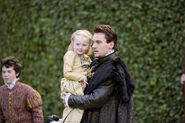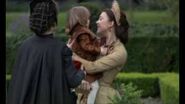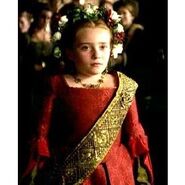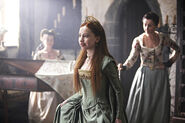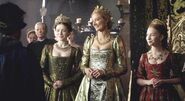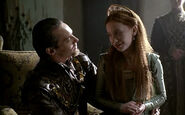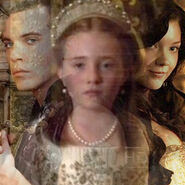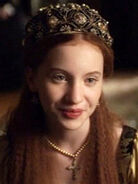- "Earlier today i made a vow to myself. As God is my witness, i shall never marry
- Elizabeth Tudor[src]
Elizabeth Tudor is the princess of England, and the daughter of Henry VIII and Anne Boleyn. She is portrayed by Irish actresses Kate Duggan in Season 2, Claire MacCauley in Season 3 and Laoise Murray in Season 4. She will eventually become Queen Elizabeth I and reign for 45 years, the last; but possibly greatest monarch of the House of Tudor.
Henry loved his daughter, Elizabeth dearly; despite hoping she would be a son; but she only knew her mother for a short time because Anne was concerned with moving forward and birthing a son, Anne also met her death; before Elizabeth was quite three years old. Anne Boleyn would reappear in a hallucination alongside Elizabeth; before Henry's death, saying she was proud of Elizabeth's intelligence and boldness, though she regretted not catering to her more; during her life; Henry replied that; he was proud of her too; but he avoided her sometimes; because she reminded him too much of Anne.
Henry declared Elizabeth a bastard after he ended his marriage to Anne and executed her; he cut off the young princess's financial support, claiming that; her mother had been a whore and denying that; she was his child. But in episode 3.03 at Christmas, Henry warmly reconciled with the four-year-old Elizabeth at the encouragement of his third queen Jane Seymour and Elizabeth's sister, Mary Tudor; she was not made heir to the throne; but like Mary she was restored to the royal line. She also had loving relationships; with her later step-mothers Anne of Cleves, Catherine Howard and Catherine Parr; but Elizabeth was not very close to Catherine Howard, like she is to Anne and Catherine Parr.
Elizabeth's personality is not shown to anything of the same degree as her older half-sister Mary, as she is first depicted as a newborn in episode 2.03 and as a little girl in most of Seasons 2 and 3; but it is clear from Anne Boleyn's intelligence, ambition and boldness, traits that; would characterize Elizabeth as queen that; she takes strongly after her mother, as when she naively states to her sister Mary that; she does not think boys should be preferred over girls. While Elizabeth has happy relationshipsl with her half-siblings Mary and Edward, as well as her step-mothers, she remains emotionally distant from her father for most of the series.
In Season 4; when she is entering her early teens, her love of reading, dancing and languages, encouraged; by her father; but traits she more likely got from her mother is seen; she also has something of a mischevous streak, unlike her more religious and graceful elder sister. Henry avoiding her frequently, looks at her with deep pride; despite her not being his heir to the throne. Elizabeth is better at concealing her true emotions than Mary. She is also shown to look after her little brother, Edward Tudor and helps teach him latin. When Catherine Parr becomes queen consort, she decides to infuse her secretly Lutheran faith in Elizabeth, preventing her from seeing her sister and mother figure, Catholic Mary.
Elizabeth would later support her sister Mary in her successful bid for the Crown against Lady Jane Grey, historians argue Mary may have distrusted Elizabeth because of her Protestantism, though they arrived together to claim Mary’s crown, and enjoyed a continuation of their close relationship, according to contemporary sources. After suspicion grew that Elizabeth orchestrated a rebellion against Mary. Despite substantial evidence Mary refused to sign the death warrant, and instead locked her in the Tower for two months before quietly returning her to court. It was clear that Mary would have no children with her Spanish husband and she was on her deathbed, she restored Elizabeth to the line of successsion, setting the stage for Elizabeth's impressive 44-year reign, known as the Golden Age. Over the course of her long and for the most part, popular reign, Elizabeth oversaw vast overseas trade expansion and exploration both set in motion by Mary, the rise of England's theatrical arts, headed by William Shakespeare and Christopher Marlowe, and the re-establishment of the Anglicanism after her sister's return to Catholic reign, Mary's often depicted as tyrannical, although she was less heavy-handed than her brother or father, fining people of different faiths rather than executing them). She accomplished all this; despite multiple attempts to assassinate her, marry her off or; prove she was not the legitimate queen.
Season Two[]
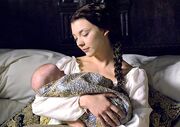
Elizabeth as a newborn; with her mother, Anne Boleyn.
Elizabeth is first shown as a newborn infant when she is born at the end of episode 2.03. She is baptized in the next episode by her godfather Archbishop of Canterbury Thomas Cranmer and her maternal aunt Mary Boleyn. After her first few weeks in the royal palace she is bestowed with her own estate (Hatfield) and a staff of ladies to look after her; including her older half-sister, Mary, who has been declared illegitimate. Henry and Anne visit her often to dote on her; Anne wishes to breastfeed her herself, but Henry forbids it because of a stigma against queens nursing their children, especially daughters. Despite her hatred of Anne and the fact that Elizabeth has usurped her place in the royal line, Mary shows her baby sister nothing but affection in caring for her. As Elizabeth becomes a toddler and starts to speak, she is shown running about frequently. Anne and Henry are unable to spare as much time for her, but Anne always embraces her daughter emotionally when they visit, and Henry showers her with affection despite Elizabeth not being the son he wanted.
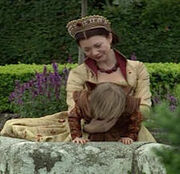
Queen Anne worries for Elizabeth's safety (episode 2.07)
However, at the end of the season Elizabeth- now nearly three years old- is declared a bastard like Mary and stripped of her royal titles and income when her mother is falsely convicted of adultery, and her marriage annulled. Henry questions whether she is even his child, which seems odd considering Elizabeth was the only one of his children who looked significantly like him. Her governess, Lady Margaret Bryan, harshly herds Elizabeth out of the house, hoping to protect her from Henry's wrath, as the King's agents confiscate some of her assets (in order to pay for her own mother's imprisonment and execution). As Lady Bryan sadly remarks to one of Elizabeth's maids that; the "child is now a bastard" the little girl watches them with frightened eyes, not yet realizing that; her mother Anne is; due to die the next day.
Season Three[]
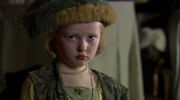
"The brat is now officially a bastard".
Elizabeth's role in the third season is somewhat smaller. Lady Bryan petitions Henry to ask for money (as Elizabeth is outgrowing her clothes and no new ones have been provided) but Henry sneeringly remarks that Elizabeth is not his child but that of Anne and Sir Henry Norris, as Anne was accused (falsely) of having relations with many men. Elizabeth's fortunes soon improve, however, when she and Mary are gifted with a beautiful and kindhearted step-mother, Jane Seymour, who eventually bears Henry the son he has always wanted; Jane privately sends Lady Bryan some money to cover Elizabeth's needs.
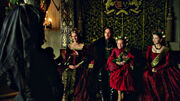
Elizabeth with her father, sister and first step-mother, Jane Seymour.
Jane and Mary eventually decide to present Elizabeth, now four and a half years old, to her father at Christmas; she arrives at court in episode 3.03 with Lady Bryan, looking extremely frightened. Henry is at first stunned to see Elizabeth, but he quickly recovers, teasing her in a familiar manner and indicating he will accept her as his daughter again. He then sets her on his lap, kissing her forehead and remarking "Je suis en famille!" to the applause of the court and the delight of Jane, Mary and Elizabeth.
After Prince Edward is born, Elizabeth, despite being happy about her new baby brother, privately expresses her belief that Henry shouldn't prefer a boy over her and Mary. Mary shuts this down gently, acting as the benevolent big sister. Elizabeth is shown less later in the season, partly because of the passage of time after Jane Seymour's death; she appears briefly in episode 3.07 to present a bouquet of flowers to Henry's newly betrothed, Anne of Cleves, who is quite friendly towards her.
Season Four[]
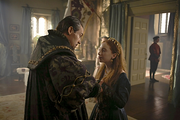
Princess Elizabeth talks; with her father, Henry.
By the events of Season Four, Elizabeth is now an eleven year old. She has rebellious attitude just like her mother. In this season, she is meant to be 4'10 inches tall. She spends a great deal of time; with her ex-step-mother, Anne of Cleves; who helps tutor her and looks on her as a daughter-figure. Elizabeth has begun to display her hunger for knowledge in this season, driven; by the intelligence and ambition she inherited from both sides of her family; she practices her foreign languages often and works to improve her dancing skills. Henry encourages her; providing her; with new books and telling her "without knowledge, life is not worth having". But despite obviously having great pride and love for Elizabeth, Henry is shown to observe her; with visible unease, reminded; by her every day of his turbulent relationship; with her deceased mother, Anne Boleyn. Elizabeth is presented to her new step-mother, Catherine Howard; but she prefers to spend more time; with her ex-step-mother, Anne; but unlike her sister, Mary Tudor; she does not have any hatred towards Catherine at all.
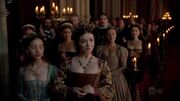
Elizabeth; with her sister, Mary at their father's wedding to Catherine Parr.
Although Elizabeth is pleased; when she and Mary are restored to the line of succession after Edward, she is disturbed by the grim fate of Katherine Howard in episode 4.05, and vows to her sister Mary that she will never marry (something she successfully holds herself to). Elizabeth is the one who notices her brother Edward's illness and alerts Lady Bryan and the doctors, helping to save his life. She develops a very friendly relationship with her new stepmother Catherine Parr, who like Anne of Cleves plays a role in her education.

"As god is my witness, i will never marry".
During the final episode, Elizabeth appears to Henry in an illusion alongside her deceased mother, Anne Boleyn; Anne expresses her pride in their daughter (which Henry shares) but they leave despite him asking her not to. In the final scenes, when Henry announces his intention to sepparate from his family in his dying days, Elizabeth does not join Mary and Catherine Parr in weeping, but leaves the castle first, with no emotion showing on her face- perhaps relieved that she is finally free of her domineering and unpredictable father, ready to face her unknown great destiny. During Henry's final flashback, one of his memories shows him playfully twirling a two-year-old Elizabeth.
The end credits show the progression of Henry's three children on the throne, remarking that; two Tudor monarchs; Henry and Elizabeth changed England forever.
Siblings' reign[]
During Elizabeth half-brother, Edward's reign, she initially stayed in the household of her stepmother Catherine Parr and Parr's new husband Thomas Seymour. After Parr caught her husband repeatedly flirting; with and possibly molesting Elizabeth; who was over twenty years Seymour's junior, she sent her to a different household. After Parr's death from childbed fever in 1548, the over-ambitious Thomas was involved in intrigues against both his elder brother Edward Seymour and his nephew, King Edward, which eventually resulted in his execution on charges of treason the next year; one of the charges was that he had been plotting to marry Elizabeth. She was interrogated, but successfully denied any knowledge or collaboration with Seymour's conspiracy.
Edward favored Elizabeth over their elder half-sister Mary; however, when his heath began to fail at age 15, he was forced to discard Elizabeth from the succession, in favor of their distant cousin Lady Jane Grey. Edward had only wanted to disinherit Mary to prevent his successor from being a Catholic; but his Privy Council insisted that he had to either disinherit both sisters or neither. After Edward's death from tuberculosis in 1553, Elizabeth sided with Mary, who had been gathering northern supporters; the sisters then marched on London, overthrew Lady Jane, her husband and their government within two weeks, and Mary was proclaimed Queen Regnant.
Elizabeth was put in a dangerous position within months of Mary's reign, being the face of the Protestant resistance to her sister. Mary reversed nearly all the edicts issued by the Protestant Edward, and Elizabeth was forced to outwardly conform to Catholicism. Mary's unpopular decision to marry Philip II of Spain (her maternal first cousin once removed) provoked a large-scale rebellion by the Protestant nobleman Thomas Wyatt the Younger. After the rebellion was crushed, Elizabeth was put in the Tower of London due to many of Wyatt's followers having supported her as Queen over Mary, but once again she was able to outwit her interrogators; ultimately they found no evidence that she was involved in the conspiracy and Mary chose to spare her sister, reintroducing her two court two months later.
Initially, Elizabeth was assumed to be off the succession due to Mary's marriage to Philip, but Philip almost never visited his wife, and while Mary had at least two false pregnancies she never produced any children. When Mary's heath began to fail in 1558, Philip supported Elizabeth's claim over her Catholic rival Mary Stuart, Queen of Scots. While her religion was an obstacle to the Catholic faction in Parliament (and to most of Europe), Elizabeth was much more popular with the English people, had a more direct claim by blood, and was readily available for an easy succession, whereas Mary Stuart was considered a foreigner by the English and betrothed to the French Dauphin. France was Spain's longtime enemy, and Philip had no wish to unite England, Scotland and France under the same succession.
Six days before her death on November 6, Mary Tudor acknowledged her sister as heir to the throne, after Elizabeth promised to retain Catholicism, a promise she did not keep. Elizabeth was crowned Queen on January 15, 1559.
The Golden Age: Elizabeth's Reign[]
Elizabeth set out to rule through a set of trusted and talented advisers, headed by her longtime chancellor Sir William Cecil. Her father Henry had ran into considerable financial problems during the later part of his reign, and resorted to a practice known as "coin-clipping" in order to stay afloat, in which coins of pure gold and silver had bits shaved off, then melted down, mixed with inferior alloys and re-minted as British currency. The ones most hurt by this were the lower classes as the peasants faced higher prices and it was harder for merchants to acquire goods and raw materials, sending England's economy into a tailspin. Mary had fixed the kingdoms finances significantly to set Elizabeth up for success, and likely even wrote the currency reform Elizabeth's parliament passed. When Elizabeth assumed the throne, she made Sir Thomas Gresham her Minister of Finance, who warned her this trick of Henry's was ruining her economy.
Elizabeth, following her sister’s plans, had all the corrupted money confiscated and reinstated the silver standard (coins of pure silver) as British money, hence the term "pound sterling", which led to a renewed, vibrant economy under her reign. She ultimately managed to pay off all the staggering debts her brother and father had accumulated, and establish successful credit with Parliament, though her naval war against Spain and her campaigns in France, Ireland and Holland left her with some debts of her own.
Elizabeth was more practical than her father or siblings about religion. While she kept most of the church reforms introduced under her brother's rule, she avoided more extreme reforms demanded by the Puritan (hard-line Protestant) faction of Parliament. Rather than executing her non-Anglican subjects simply for their beliefs, she charged them a regular fine if they didn't attend service in the Church of England. This allowed her to increase her treasury revenue while de-funding the subjects most likely to conspire against her, and she maintained relatively peaceful rule for the first eleven years of her reign.
Most Catholic rulers tolerated her at first because they assumed she would eventually make a marriage-alliance with a Catholic Prince. However, Elizabeth had seen how her sister's marriage to Phillip II of Spain had deeply offended the English people; she was also determined not to delegate any of her power to a husband or future heir, which would make her more vulnerable to a coup. She had several romantic favorites over the years (particularly Robert Dudley, the Earl of Leicester), but although she often considered (or pretended to consider) marrying various suitors, she never did, and became nicknamed "the Virgin Queen" as a result. As she grew older and her chances of having children decreased, many powerful Catholics in Europe began to lose patience. in 1570 Pope Pious V excommunicated Elizabeth, essentially ordering all English Catholics to resist her rule or be excommunicated by extension.
The most direct threat to Elizabeth's throne was the Catholic Mary Stuart, Queen of Scots; Mary's father, James V of Scotland, was the nephew of Henry VIII through his mother, Margaret Tudor. Elizabeth initially left Mary alone, as she soon became Queen Consort of France and posed less of a threat in Paris. However, after Mary's husband Francis II died childless in 1560, Mary returned to Scotland.
In Mary's absence, a Protestant faction had grown in Scotland's parliament with Elizabeth's support. After Mary's return to Scotland, scandals in her personal life (including her ill-considered and unpopular second and third marriages) provoked a series of rebellions that eventually led to her capture and forced abdication in favor of her infant son James, who would be brought up Protestant.
Mary escaped to England in 1568, where Elizabeth "offered her sanctuary" by essentially holding her under house arrest for the next two decades. Because the Papal Bull of Excommunication made Mary a rallying point for any Catholic rebellions, releasing Mary seemed too dangerous to Elizabeth, but she avoided executing her, worried about offending other Catholic monarchs. Two conspiracies, the Rising of the North of 1569 and the Ridolfi plot of 1571 both centered on Mary, though she was not actively involved. These rebellions provoked Elizabeth to introduce harsher measures against her Catholic subjects, including executing any Catholic priest who came to England on suspicion of plotting against her. Francis Walsingham, Elizabeth's spymaster, finally uncovered evidence in 1587 that Mary had sanctioned the failed Babington plot to assassinate Elizabeth and put her on the throne. For this, Mary and the Babington conspirators were beheaded, with Elizabeth's reluctant consent.
Mary's execution provoked outrage among many Catholics in Europe, and in 1588 Philip of Spain launched the Spanish Armada, intent on invading England and overthrowing Elizabeth by force. However, the Armada was scattered by the English Navy near Calais and ultimately defeated, with most of the fleet destroyed by storms as it struggled back to Spain. The Spanish defeat was mostly due to severe weather and poor logistical planning, but all the same, it was a potent propaganda victory for Protestant England, and resistance to Elizabeth's rule fell sharply afterwards. Although Elizabeth was no great military leader and (rather like her father) tended to treat her commanders harshly when they failed her, she was a skilled strategist, and by expanding and upgrading the English Navy she kept England safe from invasion by Spain or France, despite both having much larger and better-trained armies. Philip made two further attempts to invade England during Elizabeth's reign, both of which failed.
Other sea battles against the Spanish ended in costly defeats, but England continued to harass Spanish naval supremacy. Many of Elizabeth's sea-captains had engaged in government-sanctioned piracy (privateering) early in her reign, capturing and looting Spanish trade and treasure ships; this policy increased sharply after the war began. Her navy also protected new trade routes that she established with Russia, the Ottoman Empire, the Barbary States and India. One of Elizabeth's most notable explorers, Sir Francis Drake; who had been one of the captains at the Battle of the Spanish Armada- became the first English sailor to circumnavigate the globe. Another explorer, Sir Walter Ralegh, introduced and popularized tobacco and potatoes in England; he also set up a small colony in North America which he named "Virginia" in honor of Elizabeth's "Virgin Queen" nickname. The colony ultimately failed and disappeared, but a new colony (also named Virginia) was later established in the same area and prospered, under Elizabeth's successor James.
Elizabeth's military campaigns in continental Europe, mainly against the pro-Spanish Catholic League, failed; this was largely because she underpaid her troops, was too cautious in her strategy and often gave contradictory orders to her commanders. However, the factions she supported - the Dutch Protestant rebels and the pro-Protestant Henry of Navarre; who later became King Henry IV of France- were both ultimately victorious, and her contributions, small though they were, built better relations with France and the newly-formed Dutch Republic. Elizabeth's attempts to complete the conquest of Ireland were eventually successful, but at considerable cost in troops and funding, and her brutal reprisals against pro-Catholic rebellions earned her permanent hatred from the Irish.
Despite the decline of the economy toward the end of Elizabeth's reign (paralleling both her health and her temper) Elizabeth's closing years were brightened by a new flourishing in England's culture and theatrical arts, especially by playwrights William Shakespeare and Christopher Marlowe. Her careful administration had allowed England a (relatively) peaceful transition to Protestantism after the extreme reigns of her brother and father, and though her death in 1603 was received with relief by some that her "time had come", overall most of England mourned her. She was ultimately succeeded by King James of Scotland, the son of her old rival Mary Queen of Scots. James merged Scotland with England and created the nation of Britain.
Physical appearance[]
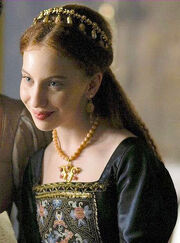
Elizabeth as a teenager.
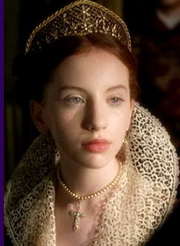
Elizabeth's final appearance in the series, foreshadowing her future role as Queen
Elizabeth is shown as a pre-teenager in the fourth season; she has inherited her father's red hair and oval face, but she has the same piercing eyes as her mother Anne (Anne and Elizabeth had black eyes historically, but blue in the series). She was supposedly the only one of Henry's children who looked significantly like him. She also has her mother's intelligence, which rather fortunately for her was greater than Henry's; this allowed her to reign with a more objective and less impulsive mind, and she selected her advisors-and dismissed them- more carefully and less frequently than her father.
Quotes[]
- (Henry VIII speaking of the infant Elizabeth): "Who knows, Mistress Bryan? Perhaps, one day, this little girl will preside over empires."
- Elizabeth: (at 4 and a half years old) "Votre Majeste, ca va?"
- Henry: (beams at her) "Ca va bien, ma petite. Come, sit here. Attention." (sets her on his lap and kisses her forehead, making her smile) "Je suis en Famille!" (the court applauds, Lady Mary and Queen Jane smile)
- Elizabeth: (trying to help her little brother study Latin) "Edward, you've got to learn this!... (sees his concentration is broken, to her exasperation) You want to go and play now, is that it? (Edward nods, Elizabeth smiles indulgently) All right, go along, Your Grace."
- Edward: (bows to her) "Thank you, Elizabeth".
- "Earlier today I made a vow to myself... As God is my witness, i shall never marry".
- The vision of Anne Boleyn, speaking of Elizabeth: "She was the only pure thing in my life, and in my life I neglected her. Since she was only a girl and I wanted so much to give you a son, but now- I am so proud of her. Fiercely proud. She is so clever, and though she is like me in many ways she is not intemperate, as I was. You must be proud of her, too, Henry?" Henry: "...I am. I am very proud of her... and I know how clever she is. And, I wish that I could love her more... but from time to time... she reminds me of you".

